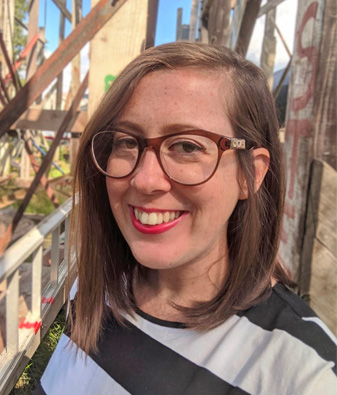Through experiential learning opportunities, Jessica Mace is helping students see the bigger picture in art history-related careers.
“When you think of art history, it's kind of an ivory tower, it's not seen as a really applicable subject to study for careers,” she says. “But it is. There's so much you can do with it.”
Mace joined the Department of Art History as a postdoctoral fellow in August 2020 for a two-year position to support the department’s Canada Constructed: Architecture, Landscape, History initiative.
Funded through the provost’s Learning & Education Advancement Fund (LEAF) Impact Grant, the aim of this project is to increase interest in the study of Canadian architecture at U of T and beyond through new undergraduate courses, internships, events and content on social media platforms, including a new website.
Under this objective, Mace worked with the department and the A&S Office of Experiential Learning & Outreach Support (ELOS) to redesign a fourth-year academic internship course. The course’s internships give students the opportunity to work with local arts organizations for a semester or academic session.
“Prior to this initiative, students would seek their own opportunities,” says Mace. “They would approach an art gallery, try to get the host and the department on board, sort out the paperwork on their own, and still not be guaranteed a meaningful work or learning experience.

“My task was to find these opportunities and approach the partners. I walked them through expectations and responsibilities and got all the paperwork sorted in advance, so that we could just advertise the positions and students could apply.”
As a result, students have enjoyed internships at arts-based partner organizations such as 401 Richmond, the Architectural Conservancy of Ontario (ACO), The Society for the Study of Architecture in Canada, TO Built and the Toronto Society of Architects.
Mace has helped facilitate 12 internships since the spring, and the student responses have been overwhelmingly positive.
Olwen Alaminos, a member of Trinity College and a fourth-year student, double majoring in ethics, society and the law, and art history, chose the Society for the Study of Architecture in Canada (SSAC) for her internship.
It was fascinating to learn about up-and-coming architectural research in areas such as ecologically sustainable religious architecture, the significance of graffiti in the creation of urban cityscapes, and Indigenous approaches to design.
She helped prepare for and execute the society’s annual conference.
“I was intrigued by the rare opportunity to see the practical side of work in the world of art and architecture,” says Alaminos.
She attended regular meetings to discuss conference planning, created promotional materials for key conference events, and communicated directly with conference presenters.
“It was fascinating to learn about up-and-coming architectural research in areas such as ecologically sustainable religious architecture, the significance of graffiti in the creation of urban cityscapes, and Indigenous approaches to design,” she says.
“I truly enjoyed my time working with the SSAC, and the valuable connections I gained. Every society member I met was welcoming and encouraging, and I received the added bonus of membership in the society for a year!”
“That was part of the mandate with searching out these partners. The students shouldn't just be doing grunt work,” says Mace. “They should actually be contributing to the organization and getting something back from them as well.”
Mace also added an experiential learning component when she helped redesign the fourth-year Studies in Canadian Architecture course, which she taught under the theme of “Hidden Canada.”
“The course had been offered before, but I was given free rein on it,” she says. “Again, I worked with the ELOS office on how to make this an experiential learning opportunity.”
That opportunity involved students working with the Architectural Conservancy of Ontario NextGen program to produce a series of articles on innovative architectural topics for the ACO’s new blog.
It's been great — they're developing writing skills, research skills and communication skills that can be applied in so many different areas.
“I broke it down into a number of different steps,” says Mace. “Students were introduced to some ACO reps at the start who helped frame the project and give them ideas on topics that would be of interest and later offered one-on-one research support. They also met with the editor of Canadian Architect to talk about how to write a public piece.”
The result was a series of well-received articles that covered topics such as protecting Indigenous spaces, celebrating a spiritual centre of the Taoist community, and incorporating greenspaces when designing Canadian suburbs.
Mace has been thrilled with the students’ contributions for both articles and internships.
“It's been great,” she says. “I really like having students do something that's not just a paper that sits on my desktop. They're developing writing skills, research skills and communication skills that can be applied in so many different areas.
The real reward has been seeing the students discover Canadian architecture and heritage in a new way, or thinking about art history in a new way, or just making those kinds of connections with the arts community.
“It's a bonus that we can get students interested in the built environment and heritage around them, because this is the place where they live and work. So why not take an interest in those topics and learn more about them.”
For her work in this course and for creating such beneficial learning opportunities for students, Mace was nominated for the ACO’s NextGen Award that recognizes an individual early in their career for outstanding contributions to the field of heritage.
While humbled by this nomination, the real reward has been “seeing the students discover Canadian architecture and heritage in a new way, or thinking about art history in a new way, or just making those kinds of connections with the arts community,” says Mace.
“Even the students who just signed up for an elective, I see them getting really into their research projects and thinking them through, and asking me for more opportunities, even after a course ends. That’s so rewarding.”

